Attractions Near HaNeviim Street In Jerusalem
Jerusalem HaNeviim street day trip will visit Holy Trinity Cathedral, Italian Hospital, Ethiopian Orthodox Church, and other attractions. Let’s begin!
Note: this post includes the description of our actual day trip along HaNeviim street in Jerusalem. And I hope it will give you ideas for your travels.
Table of Contents
Map
In order to better understand the route let’s look at Jerusalem walks map. This trip is marked with the blue tram.
The route:
Map of the area:
Directions
As usual, we have parked at Ammunition Hill. It is a park and ride site (free parking) for the light trail. And from there you can take the light rail to Safra square. The city hall is located on Safra square and it is also close to the Old City.
The light train:

Jerusalem City Hall
Inside the city hall complex:
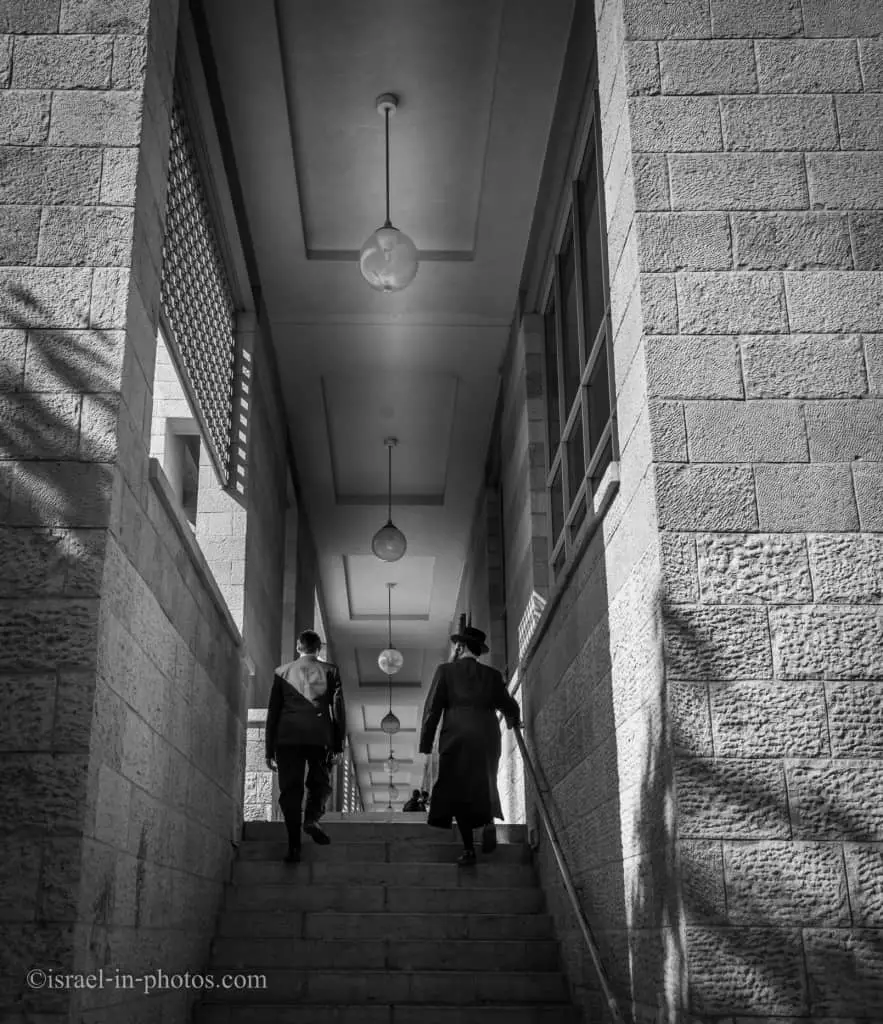
It is not that I had a business in Jerusalem’s city hall, well actually I did. I was looking for the restroom 😉 It’s on floor -2, and there is an elevator from the Safra square.
And since we mentioned the city hall, I wanted to say that there are tours in Jerusalem city hall.
The tour at the Visitor Center of the Jerusalem municipality includes the city council hall, amazing model of old/new Jerusalem and an observation point offering a breathtaking view of Jerusalem’s neighborhoods.
They provide a 1.5-hour tour. And it costs 150 NIS for up to 15 people (and 10 NIS for an extra person). And since this is a tour for groups only, and you have to prebook it in advance, I never participated in one. But one of my friends did, and he said it was lovely.
You can find additional details about the tour here.
Holy Trinity Cathedral
Our first station was Holy Trinity Cathedral that’s located on Moscow square:
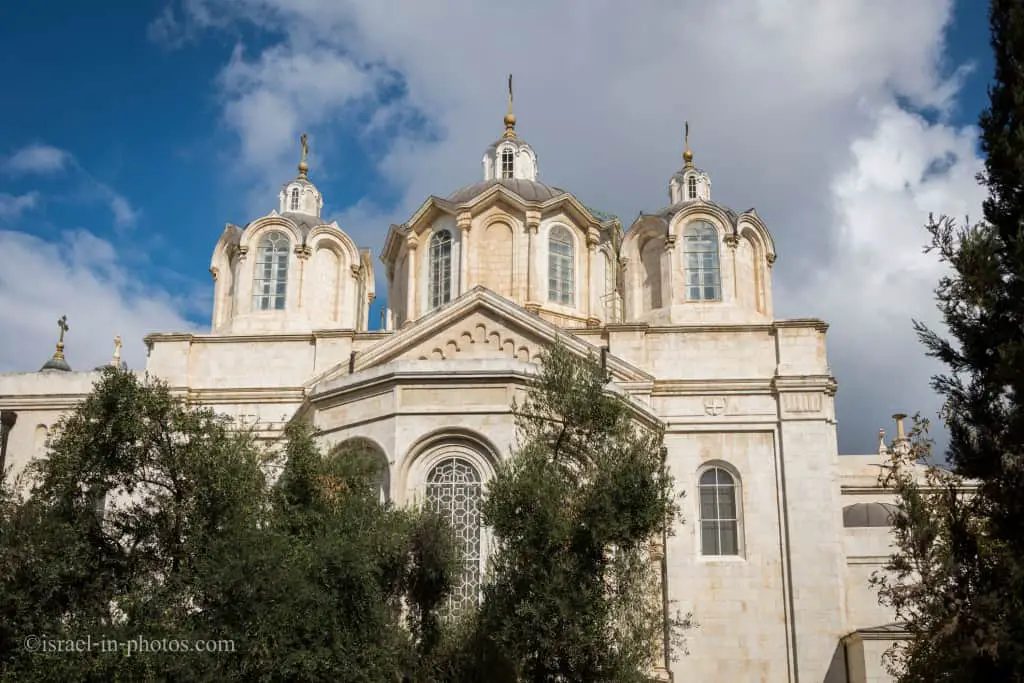
Background
The Holy Trinity Cathedral is a cathedral of the Russian Orthodox Church in Jerusalem. The cathedral was built in 1860–1872 by a Russian Orthodox institute that operated in Jerusalem, under the Ottoman Empire government.
The Cathedral of the Holy Trinity was officially founded on 11 September 1860. In 1864 the outside was completed, but the construction was suspended due to budgetary issues. By 1872 the cathedral was luxuriously inaugurated, in a ceremony where Duke Nicholas participated. Since then the cathedral is used by pilgrims and locals. The author of the project was a Russian architect Martin Eppinger. It was initially supposed to be consecrated as the church of St. Alexander Nevsky (the patron saint of Alexander II), but finally, it was decided to dedicate the Cathedral of the Holy Trinity.
In 1895 to 1897, the cathedral was renovated. The process included repairing the roof and fixing a blind area. Further, the glutinous paints on the walls of the Cathedral were scraped off, and three interiors were painted white, and then the cathedral was decorated with sacred images. Near the altar, an indoor emergency exit was built.
In the period of the British Mandate, the Trinity Cathedral remained independent and was in the jurisdiction of the Russian Orthodox Church Outside of Russia.
During the first Arab-Israeli war, the temple was badly damaged. From 1948 it is in the jurisdiction of the Russian Orthodox Church.
Source: Wikipedia
The sign next to Holy Trinity Cathedral:

The interior is quite beautiful. All walls are covered with paintings, but you are not allowed to take pictures inside 🙁
Opening Hours
Currently, the Cathedral is opened for visiting every day from 9:00 a.m. till 1:00 p.m., except Mondays. On Sundays and other Church Feasts, it is opened from 8:00 a.m. before midday.
The cathedral is next to police station/prison, so this is the view you get from the other side:

And here is a closeup photo:

Italian Hospital
Many people pointed out that the Italian Hospital is one of the most beautiful buildings in the city. Thus we decided to go out and see it.
It is located at HaNeviim Street 13 and Shivtei Yisrael Street 29.
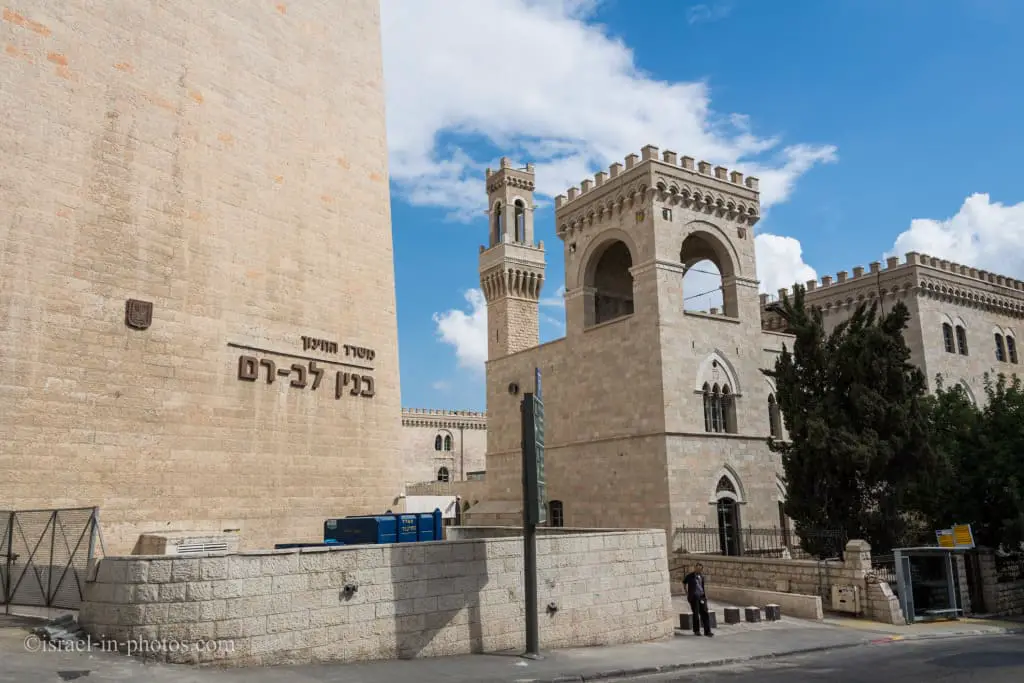
The building, reminiscent of medieval Italian buildings, is a monument to a period of prosperity and the return of the city from a marginal city to the center of international importance.
The building served as a hospital under Italian sponsorship between the two world wars and is now used by the Ministry of Education. And unfortunately, you can only take a look from outside.
Background Information
At the end of the 19th century with the disintegration of the Ottoman Empire and its opening to the influence of the European powers, France, Germany, Britain, and Russia fought for influence and prestige in the city of Jerusalem. Until that time, the city was neglected and considered as a negligible city at the end of the Ottoman Empire, with a poor population and a backward feudal economy.
The choice of Jerusalem as a battleground between the superpowers stemmed from a Christian religious belief combined with missionary activity and vivid memory of the days of the Crusader Kingdom of Jerusalem. HaNeviim street was one of the primary streets in West Jerusalem, which served as the main traffic route to the west of the Damascus Gate. It was the center of the happening, and along HaNeviim street (and its branches), a large part of the European construction activity took place.
The Italian government, like other countries and separately from the Holy Throne, sought to demonstrate its presence in Jerusalem by establishing an impressive hospital to serve the local population, especially the Catholic pilgrims who came to visit the city. The initiative, which was relatively late for the activities of the other countries, was initiated by an Italian Christian organization called the Associazione Nazionale per Soccorrere I Italian Missionary.
Planning And Construction
In 1912 the Barluzzi brothers came to Jerusalem to plan this building. And you probably heard about Antonio Barluzzi who planned and built many churches and other types of buildings around Israel.
The hospital building was designed in style typical of Italian public buildings of late medieval Italy, also known as Italian Gothic style. It is characterized by elements such as pointed arches, pointed roofs, towers, and especially stone ornaments made of lace and many decorations and sculptural details that enveloped them.
The sources of inspiration for the hospital’s planning can be seen in the Gothic revival movement that attempted to reconstruct the Gothic architecture of the Middle Ages in Europe using more modern means and contexts. A significant influence on the renaissance of Gothic art was the Romantic movement of the 19th century, which adored this architecture as the splendor of romantic creativity.
In general, the hospital building is reminiscent of famous Italian buildings such as the Palazzo Vecchio in Florence’s Signoria Square and the Santa Maria del Fiore, Florence’s Duomo, alongside buildings in the city of Siena, Torre del Mangia and the nearby Palazzo Pubblico.
Source for both quotes: translated from Wikipedia
View from Shivtei Israel street:

Mea Shearim
Note: Mea Shearim is also spelled as Mea She’arim.
Mea Shearim street is located behind the Italian Hospital. It is one of the oldest Jewish neighborhoods in Jerusalem. It is populated mainly by Haredi Jews. And before entering this neighborhood you will see modesty signs, like this one:
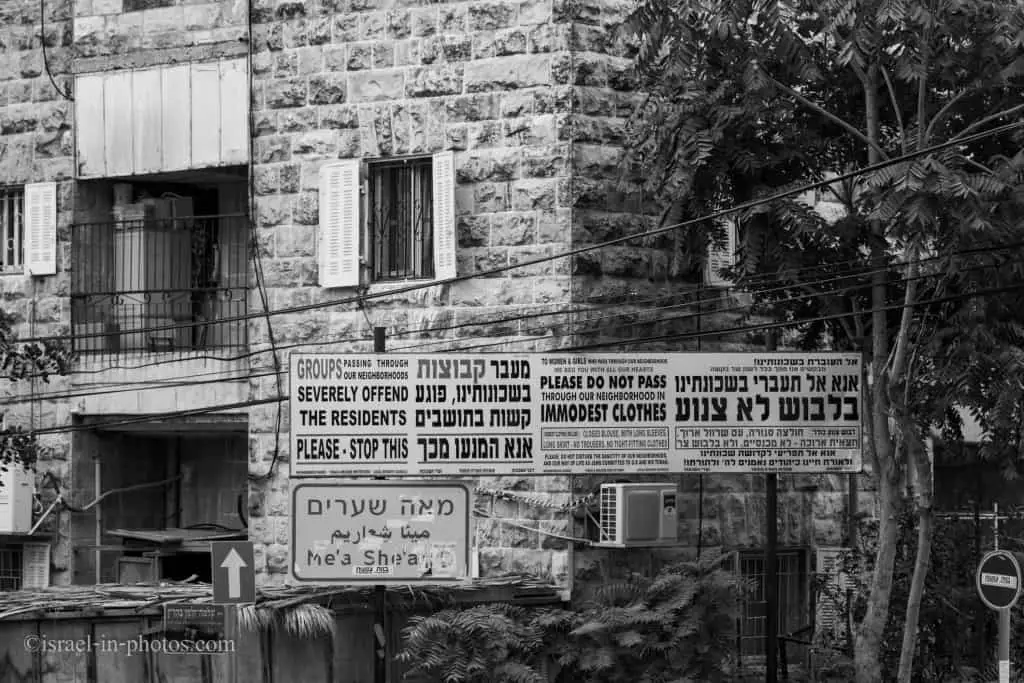
Mea She’arim in Hebrew means one hundred gates or a hundredfold. The name is derived from a verse in the weekly Torah portion which was read the week the settlement (neighborhood) was founded: “Isaac sowed in that land, and in that year he reaped a hundredfold; God had blessed him” (Genesis 26:12). Also, according to a tradition, the community initially had 100 gates, another meaning of Mea Shearim.
Clothes on a drying rack in Mea Shearim:

And clothes on drying rack two hundred meters from there:

We did not go into Mea Shearim since I love photographing and Hasidic population does not like when their pictures are taken.
In general, if you want to visit this neighborhood, I would suggest joining a tour.
Ethiopian Orthodox Church
We went back to Ha-Neviim street and continued till Ethiopia street. On this street you can find the Ethiopian Orthodox Church:

Entrance gate:
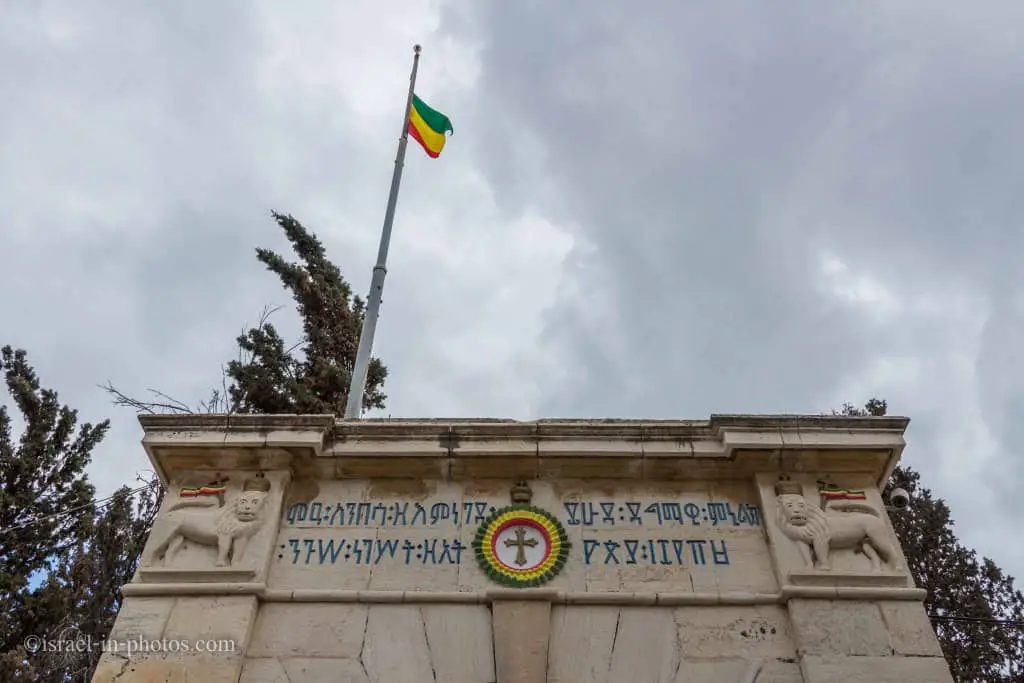
The sign next to Ethiopian Church compound:

The Ethiopian Orthodox Church has maintained a quiet presence in Jerusalem for more than 1,500 years, with some people claiming that there has been an Ethiopian delegacy in the Holy Land ever since the famed meeting of the Queen of Sheba and King Solomon some 3,000 years ago.
For many centuries, the center of the Ethiopian Church in Jerusalem was a small courtyard with several structures behind the Church of the Holy Sepulchre in the Christian Quarter of the Old City. Today, however, the Church has, to a large extent, relocated outside the walls to the western city. The move began in the 19th century when a succession of powerful Ethiopian monarchs decided to establish a strong presence outside Africa. In 1888, Ethiopian Emperor Yohannes bought a large plot of land and began construction of a new church and monastery. The complex eventually lent its name to the road on which it is situated – Ethiopia Street.
The new church is an impressive structure in a secluded courtyard, built in the circular style reminiscent of other Ethiopian churches. The complex is usually a haven of tranquility in the heart of downtown Jerusalem, but during Easter, things pick up, and it is recommended to visit and witness the lively services. Remember to take off your shoes at the entrance as this is a requirement of the Ethiopian rite.
Source: itraveljerusalem.com
One of the unique things regarding the Ethiopian Church is that the structure is round:

From there we continued towards Mahane Yehuda Market.
Sundial On Zoharei Chama Synagogue
On Yafo street, you can see 5 meters diameter sundial on the facade of a building.
It is on the top of the Zoharei Chama Synagogue. The name in Hebrew means Sunrise Synagogue.
The aerial sundial on the fourth floor of the building was designed by Rabbi Moshe Shapiro, a watchmaker in Mea Shearim and a self-taught astronomer. Shapiro had built sundials for the outside walls of other synagogues, such as the Hurva Synagogue in Jerusalem’s Old City, and would go on to build sundials for at least 15 other synagogues in Israel.
Sundials were of crucial use for Haredi synagogue-goers who needed to know the exact time of sunrise to begin their morning prayers, the precise time of sunset to complete their afternoon prayers, and the time for lighting Shabbat candles since these times vary day by day and season by season. Before the Zoharei Chama sundial was erected, Haredi Jews would climb to the top of the Mount of Olives or the hills of Bayit Vegan neighborhood each morning and evening to observe the times of sunrise and sunset. The third floor of Levy’s building originally included an eastern-facing wooden porch which allowed worshippers to see the sunrise easily.
For cloudy days, Levy installed two mechanical clocks on either side of the sundial, one set for European time and one for local time. Shapiro also designed three sundials for the third floor of the building. Only the large sundial on the fourth floor remains today. It is still accurate to within 15 minutes.
Nachlaot
We have passed through Mahane Yehuda Market and visited Nachlaot (cluster of neighborhoods). Nachala in Hebrew means homestead. Nachlaot is known for its narrow, winding lanes, old-style housing, hidden courtyards, and many small synagogues.

Yitzhak Navon, fifth Israeli president, grew up in Nachlaot and later on, he wrote Bustan Sephardi (Spanish Garden) musical. This musical tells the story of Ohel Moshe neighborhood during the thirties (of last century). The vibrant life of the residents is presented via funny stories. That is the oldest show that’s presented by Habima theater. The musical was shown more than 2,000 times, and you can still see it today.

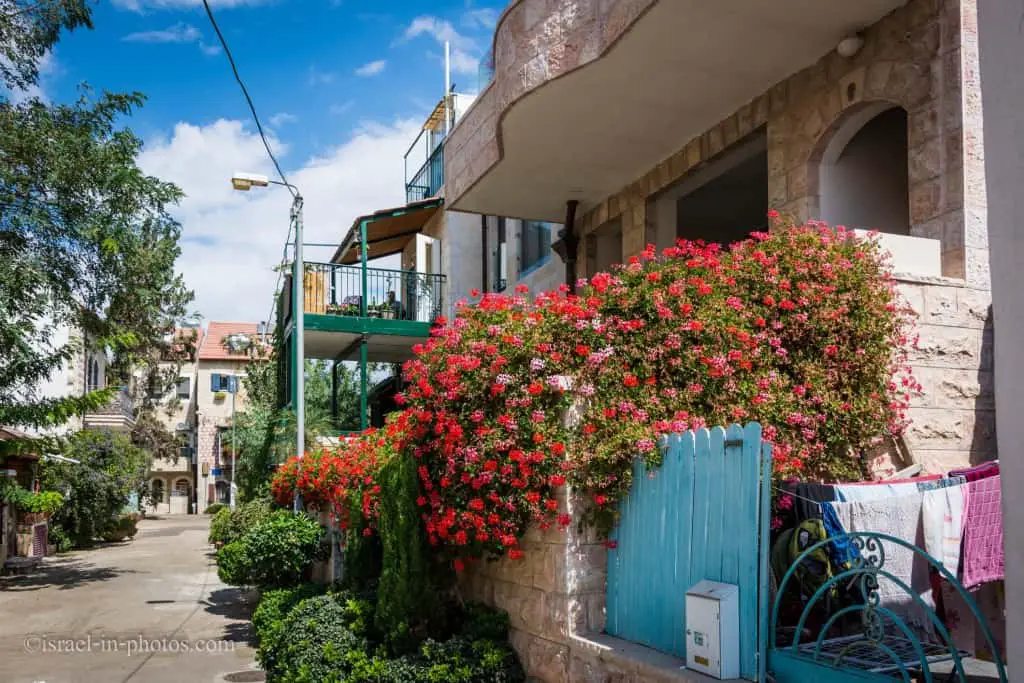
And here is the Ohel Moshe synagogue:

Here is another synagogue with beautifully carved doors:


A couple of years ago, a reservation project was started. Today on many buildings in the neighborhood, you can find explanations regarding buildings, and it is owners/residents.

You can find more details about Nachlaot at Machane Yehuda Market tour that we attended recently.
Mahane Yehuda Market
Since it was lunchtime we headed back to Mahane Yehuda Market. The market has undergone many changes in recent years. Nowadays there are not only stores in the market, but there are restaurants and pubs as well.

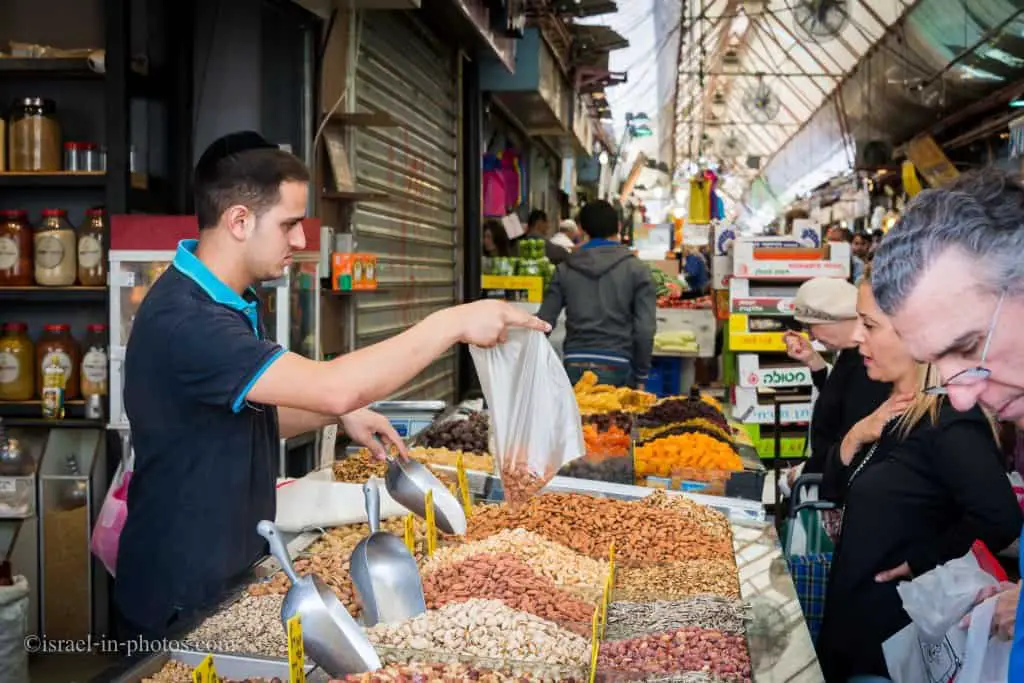
And here is a pub in the middle of the market next to vegetables stand:

During that day I have noticed there are many bakeries in Jerusalem. Much more than in Tel Aviv for example. When I see many bakeries, it usually tells me that the population is poorer. In most modern countries, as the population becomes richer, it starts to eat more meat/fish/vegetables and less dough, potatoes, rice, and other similar products. Well, fewer carbs. To check my hypothesis, I checked the average wages. And indeed the average wage in Tel-Aviv is higher than in Jerusalem (though correlation does not mean causation).


Mahane Yehuda street:

Most of the bakeries are not inside the market, but on the streets near it. Thus, you can see workers bringing bread and other goodies:


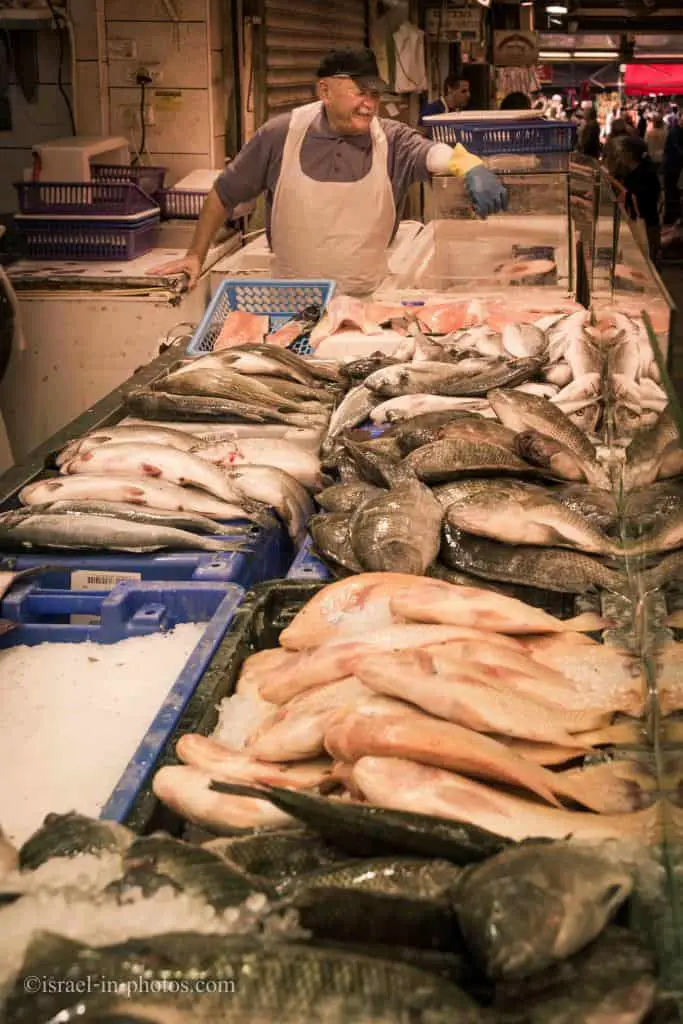
There is a famous drinks store. It’s famous due to its marketing strategy. They don’t sell drinks and juices, but solutions to problems. For example, you caught a flew and want something to strengthen your immune system. You can ask them, and they will recommend a drink.
Here is a photo of the Rambam’s drink and what it is good for:

If you are interested in additional details, then check out my full guide about Machane Yehuda Market.
Lunch At The Market
As I mentioned before, it was lunchtime and we went to a restaurant (inside the market). Unfortunately, I do not remember its name, but here is the look from our table towards the market:

My wife took two starters:

Here she demonstrates how you usually eat hummus:

You do not eat it with a fork, but you wipe it with pitta. Of course, you can take the falafel balls and wipe hummus as well.
Interestingly, the Israeli desert called the Negev, and in Hebrew, Lenagev means to wipe. As if somebody wiped the water off the land (similarly to wiping hummus). And even when there is rain in the Negev, the water is not absorbed, and sudden floods can occur. So the “wiping” occurs due to ground structure.
I took Siniya. It is mince with rice, Tahini on top and a side salad.

Late lunch completes our Day Trip To Jerusalem. Well, this was not a full day trip, but rather a six hours trip (but you can easily extend it to a full day).
From the market, we took the light train (on Yafo street) back to the parking.

Summary
In this day trip along HaNeviim street, we visited many attractions. But there are others as well. For example, along the way you can stop at the Museum of Underground Prisoners, Ticho House, and Kokia House Visitor Center. However, among all the mentioned POI, I would consider only the Machane Yehuda Market as “first-time” attraction, i.e., places you should visit on your first visit to the city. For most people, all mentioned POI (except the market), should be second priority.
What are your favorite attractions near HaNeviim street?
That’s all for today, and I’ll see you in future travels!
Stay Tuned!
For additional points of interest nearby check out Jerusalem page.
Additional Resources
Here are several resources that I created to help travelers:
- Trip Planner with Attractions and Itineraries is the page that will help you create your perfect travel route.
- What is the Best Time to visit Israel? To answer this question, we will consider the weather, prices, holidays, festivals, and more.
- Information and Tips for Tourists to Israel will answer the most common questions tourists have about Israel (including safety, passports, weather, currency, tipping, electricity, and much more).
- Israel National Parks and Nature Reserves include a complete list, top ten, map, tickets (Israel Pass, Matmon, combo), and campsites.
- If you are looking for things to do, here are the pages for Jerusalem, Tel Aviv, Haifa, Sea Of Galilee, Akko (Acre), Eilat, Nazareth, Safed (Tzfat), and Makhtesh Ramon.

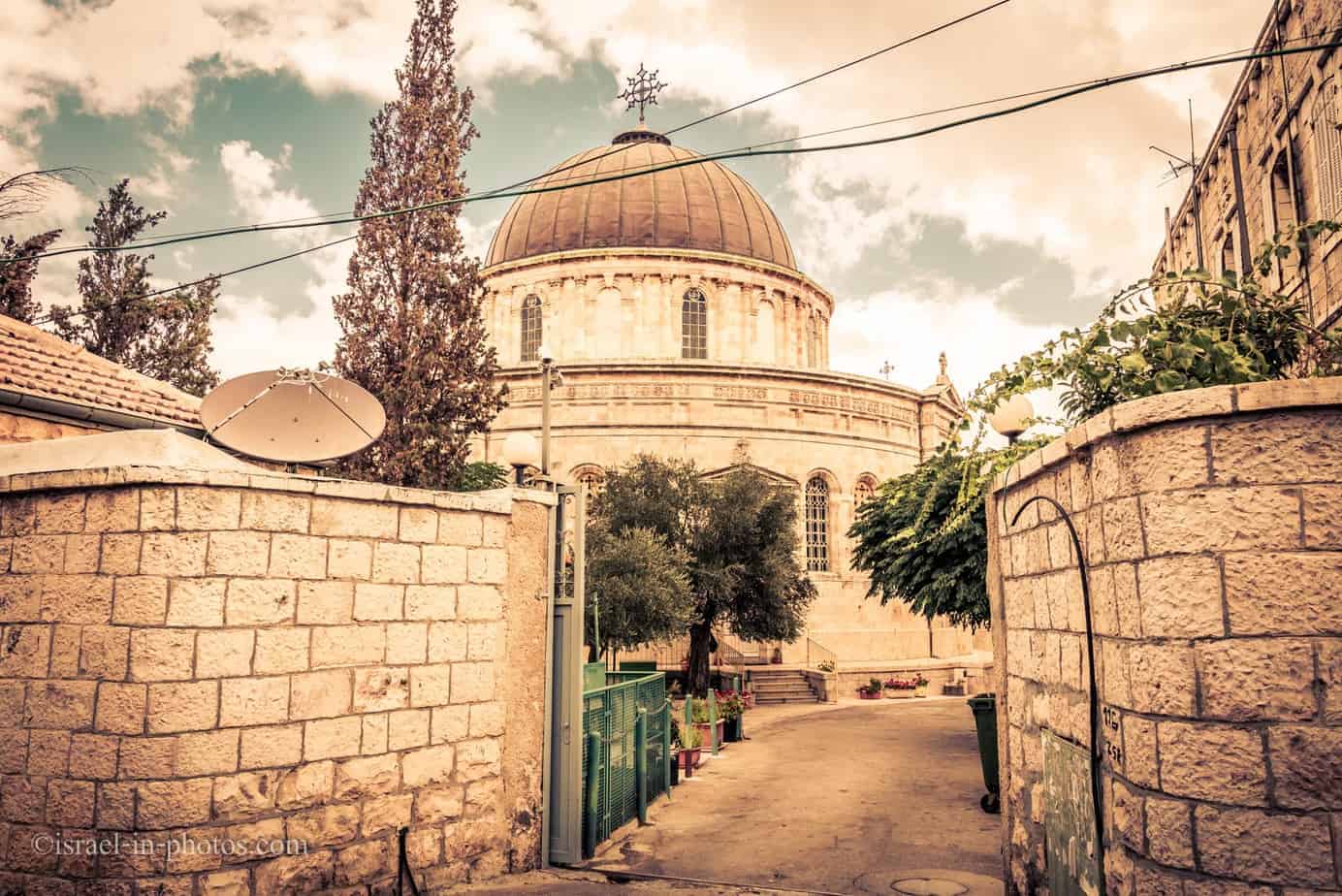






If you are going for most excellent contents like I do, only go
to see this website all the time as it provides quality contents,
thanks
What’s Going down i’m new to this, I stumbled upon this I
have discovered It positively useful and it has helped me
out loads. I’m hoping to contribute & aid different users like its helped me.
Great job.
This is my first time pay a quick visit at here and i am truly pleassant to read everthing at single place.
Hey very interesting blog!
Hey there are using WordPress for your site platform?
I’m new to the blog world but I’m trying to get started and
create my own. Do you require any coding expertise to make your own blog?
Any help would be greatly appreciated!
Yes, I’m using WordPress.
For most tasks coding experience is not required. You can find plugins that can do almost everything.